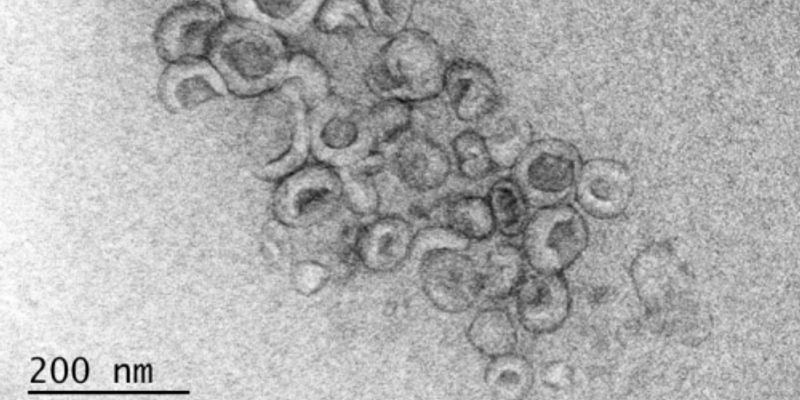Extracellular Vesicles (EVs)
Extracellular Vesicles (EVs): are nanosized, membrane-bound vesicles released from cells that can transport cargo-including DNA, RNA, and proteins-between cells as a form of intercellular communication. ... (a) Exosomes and microvesicles (MVs) are produced by normal and diseased cells.
-
OCT 21, 2025 | 7:00 AMGlioblastoma (GBM) is an aggressive brain tumor characterized by marked intra- and inter-tumoral heterogeneity and inevitable recurrence. Although extracranial metastasis is rare, circulatin...SEP 25, 2025 | 7:00 AMUltracentrifugation (UC) remains a widely used method for isolating extracellular vesicles (EVs), but debates persist around yield, integrity, and optimal protocols. In this webinar, I will...SEP 11, 2025 | 7:00 AMABSTRACT ABSTRACT ABSTRACT Learning Objectives LO 1 LO 2 LO 3 Webinars will be available for unlimited on-demand viewing after live event. Labroots is approved as a provider of continuing ed...SEP 10, 2025 | 11:00 AMBrain-derived extracellular vesicle (EV) biomarkers represent a promising frontier for liquid biopsy development targeting the nervous system. They offer strong potential for enabling minima...MAY 28, 2025 | 7:00 AMIn recent years extracellular vesicles (EVs) have become one of the most studied entities due to their ability to regulate gene expression and alter the function of various cell types. There...APR 02, 2024 | 8:00 AMCirculating tumor cells (CTCs) and circulating tumor DNA (ctDNA) have each gained attention as promising liquid biopsy markers, offering molecular insights into cancer progression, overall s...SEP 26, 2023 | 8:00 AMJoin us for an educational webinar that delves into the fascinating world of Extracellular Vesicles (EVs) and their impact on biomedical research and medicine. In collaboration with ExoVecto...Speaker: Roland Leathers, PhD , Jeroen de Vrij, PhDSponsored By: Thermo Fisher Scientific/GibcoExtracellular vesicles (EVs) are lipid-bilayer enclosed nano-sized vesicles that are released by all cell types and found in all bodily fluids. EVs are emerging as important regulators of bo...
SEP 14, 2023 | 9:00 AM
Small extracellular vesicles (EVs) and Exosomes released by cells, have gained significant interest in biomedical research due to their potential applications in diagnostics and therapeutics...
NOV 01, 2022 | 8:00 AM
Date: November 01, 2022 Time: 8:00am (PDT), 1:00am (EDT), 4:00pm (CEST) This webinar will focus on sub-micron particle analysis utilizing high sensitivity violet side scatter detection. We w...
SEP 14, 2022 | 10:00 AM
Date: September 14, 2022 Time: 10:00am (PDT), 1:00pm (EDT), 7:00pm (CEST) Virus-like particles (VLPs) are nanostructures that possess diverse applications in therapeutics, immunization, and...
Speaker:
John Tigges
, James McCracken
, Cecilia Cavazzoni
Sponsored By: Beckman Coulter Life Sciences
MAR 31, 2022 | 6:00 AM
Date: March 31, 2022 Time: 6:00am (PDT), 9:00am (EDT), 3:00pm (CEST) The CytoFLEX SRT Is a compact cell sorter capable of handling the variety...
OCT 06, 2021 | 9:00 AM
Date: October 6, 2021 Time: 9:00am (PDT), 12:00pm (EDT) ANTIBODY TITRATION is critical to the success of any flow cytometry experiment. This is even more so in microflow cytometric analysis...
JUN 08, 2021 | 9:00 AM
Date: June 8, 2021 Time: 9:00am PDT Reducing the spread of highly infectious and deadly diseases within the population, vaccine development is crucial in saving millions of lives each year....
Speaker:
Laura Chapman
, Ketil Pedersen, Ph.D
, Alexander "Sasha" Vlassov
, Matt Mckenna
Sponsored By: Thermo Fisher Scientific
NOV 05, 2020 | 7:00 AM
DATE: Date needed, 2020 TIME: Time needed Exosomes are a population of naturally occurring mobile, membrane-limited, 30 – 100 nm in diameter, extracellular vesicles containing a large...
Speaker:
Jorge Escobar
, Aurélie Tacheny
Martin highlights various factors impacting molecular analysis from FFPE samples and key challenges and considerations while working with this precious yet challenging sample type. Learning...
Speaker:
Martin Schlumpberger, PhD
Extracellular vesicles (EVs) are lipid bilayer-delimited pieces of cells that are released from the plasma membrane as "ectosomes" and from the endosomal system as "exosomes.&...
Extracellular vesicles (EVs) are nanosized vesicles containing active proteins, lipids, and different types of genetic material such as non coding RNA species, related to the characteristics...
MicroRNAs (miRs) are small non-coding RNAs whose expression is altered in several types of human cancers. Recent evidence supports their inter-cellular transfer through extracellular vesicle...
Extracellular vesicles (EV) from many cell types have demonstrated therapeutic potential against many different diseases. Inhibiting progress in this area is the capability to produce EVs in...
Chronic kidney disease (CKD) is a major public health threat, affecting 11-15% of the U.S. population alone. Currently, there are no effective therapies to cure CKD. Drug therapies are not p...
Learning Objectives: 1. Understand methods of isolating and enriching exosomes along with their pros/cons of the different techniques 2. What do we mean when we talk about subtyping, and wha...
























